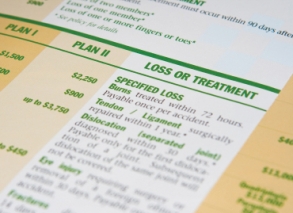Understanding Health Insurance

- Step up your acronym game – Because healthcare in the United States is a bureaucratized inefficient mess, it's important that you be familiar with all the options available to you from your Managed Care Organization (MCO). It's confusing, but you need to figure it out to make the right choice.
- HMO and PPO – Under a Health Management Organization, you choose a primary care physician (PCP) and visit them about any medical issue; you are only covered if you see a specialist on the HMO's list. Under a Preferred Provider Organization (PPO) you have a greater choice of where to receive services, but you also pay more out of pocket.
- POS and EPO – A Point of Service (POS) plan is half-HMO, half-PPO: you choose a PCP and visit them for referrals. Once a referral is made, you can opt to stay within the network, or venture outside and pay more out-of-pocket. An Exclusive Provider Organization (EPO) offers a similar service but with less variety.
- Choice vs. cost – The choice afforded by traditional health insurance is nice, but you pay the price in the form of high premiums. PPOs offer an excellent balance between choice and economy.
- Employer's health insurance – Even if the acronym of your employer's health insurance is not your preferred system, the savings received will more than make up for a possible lack of choice.
Healthcare lingo is complicated. A simple discussion about managed care (one of my favorite pick-up topics) can quickly sound like an eighth-grader’s text messaging free-for-all. Negotiating this slew of acronyms can be infuriating, but not knowing
how your plan works can cause serious confusion and cost you a significant amount of money.
There was a time when if you had a problem, you went to a doctor and your mom paid the bill while you fired up the old-school Pacman machine in the lobby. Now you have to select a PCP from a list provided by an HMO. Confused? Me too. But now that you’re on your own and potentially off your parents' plans, you need to figure out one that best fits your needs. Read on for clarification and advice in navigating the world of managed care.
The Big Picture
All health insurance works basically as follows: In exchange for a monthly premium, you can visit doctors or specialists when issues arise, and your insurance companies will pay for what they think it should cost. Most of the time, there isn’t much of a disparity between the doctor’s billing and what the insurance company considers appropriate, but keep in mind that they basically reserve the right to pay (or not as the case may be) for whatever part of the bill they want. Either way, if you get hit by a car, fracture fifty bones, and need facial reconstructive surgery, those pesky thousands in premiums just saved you somewhere around a million bucks.
To slightly complicate matters, most insurance plans require a deductible, a co-pay, or both. A deductible is the predetermined amount that you have to spend on medical services in a given year before the insurance company starts ponying up. Sensibly, the lower the deductible, the higher the price of the plan, because your insurance is ostensibly agreeing pick up a larger portion of the bill.
So how do you choose? Think about it this way: if you are a tri-sport athlete with no history of health problems whatsoever and only plan to see the doctor for a yearly checkup or if you get mangled in the aforementioned car crash, you will probably go for a cheaper plan with a higher deductible (say $15,000) and suck up the cost of the visit. However, if you are a tri-sport athlete with a history of knee, ankle, foot, and heart problems and a penchant for hypochondria, you will probably want to pay a higher monthly premium for a low deductible so you can visit doctors free of charge to your heart's content.
Well…almost free. And that’s where the co-pay comes in. Basically, health insurance companies hate giving away anything for free and make you pay a small amount (between $5-$20) for seeing a doctor after you’ve already gone over your deductible. Not so complicated, right?
Oh yeah, one more thing. Some insurance companies also cap the amount of out-of-pocket expenses you will have to pay ("yay," say hypochondriacs) but also put a maximum on the amount they will cover ("boo," says the poor bastard in a car crash). And that’s where the similarities end and the acronyms begin. Nowadays, almost every company or individual insurer has to choose between a number of different plans called Managed Care, each of which has its own acronym that doesn’t really correspond in any way to what the plan offers, just for extra confusion’s sake. Fortunately, I’ve provided a handy guide to acronymic success, replete with dating analogies for extra easy acronym surfing.
Managed Care
What is managed care?
Managed care is a bureaucratized system of health insurance that helps insurance companies make money while placing limits on the doctors and services a subscriber can use. Because the client’s selection is limited and often not as good, the managed care organization (MCO) creates lower costs for itself, which in turn leads to lower health insurance premiums for the client.
Think of it this way: if an MCO were a bar, they would only serve one kind of beer (in the case of most MCO’s, something akin to MGD). They can get a great deal on the ale because they’re buying in bulk and only need to cut one check to a single supplier. They can then charge far less for a pint than their wide-variety-carrying competition. The insurance world being insane as it is, almost everybody these days (and certainly 99.999% of recent graduates) will be on one Managed Care plan or another. So, be sure to know the rules of your MCO.
There are several types of MCOs, each with an acronym making them sound like a municipal airport—HMO, PPO, POS, and EPO. Whichever on you choose, you are going to want to find the right primary care physician (aka doctor)—your doc will determine which specialists you see and can greatly influence the quality of the care you receive.
HMO
In an effort to keep costs down, Health Maintenance Organizations (HMOs) place restrictions on the services a patient may receive. Under an HMO, the policyholder chooses a primary care physician (PCP) from the HMO’s list. After you choose your PCP, you must visit them for any medical issue. The PCP then decides whether your ailment is bad enough to warrant visiting a specialist. But you are only covered if you see a specialist that is part of your plan. This system keeps costs (and your premium) low, but can be annoying if you want to skip the step of visiting our PCP.
It’s a lot like being in a relationship. If we want to have a purely platonic lunch with someone of the opposite sex, you first have to get it cleared with your sweetheart. If not, you face a major hassle.
PPO
Preferred Provider Organizations (PPOs) give you a choice of where to receive services, with the possibility of paying more out-of-pocket depending on where you choose. If you have a problem, you can go straight to the specialist without first getting approval from your PCP. If that specialist is a member of the PPO, insurance covers a much higher percentage of their services (up to 100%, depending on the plan). However, if you don’t like their specialists and want to see the best orthopedic surgeon in the area—who happens not to be a member of the PPO—you will still be covered for a certain percentage of the visit.
Continuing the analogy from before, PPOs are like being in a relationship with a partner who doesn’t care if you cheat on them as long as it’s with a prostitute. Check out some tips on choosing between HMOs and PPOs.
Ultimately, going out-of-network for medical services can cost you thousands of dollars in expenses that you could have avoided. Unless you are very uncomfortable with the choices given, there is no reason not to stay within your network.
POS
Point of Service (POS) plans are the beautiful lovechild of HMOs and PPOs. Like an HMO, you choose a PCP and visit them for referrals. Once a referral is made, you can choose to stay within the network, or venture outside and pay more out-of-pocket, just like with a PPO. Sometimes, you can even skip the visit to your PCP if you know the out-of-network specialist you would like to visit.
In terms of relationships, a POS is like being French. Additional info on POS plans.
EPO
An easy way to understand an Exclusive Provider Organization (EPO) is to think of it as a PPO that just jumped into a really cold pool and is suffering from a serious case of shrinkage. The list of providers you can visit is much smaller than with a PPO, and if you go out-of-network your services may not be covered at all (except in emergency cases).
You’ve basically just gone from France to prison. Here are some things to think about before joining an EPO. Seriously consider whether an EPO is worth the savings—the selection of providers is just too small, and if we have to go out-of-network we must cover the entire bill.
Check out this glossary of healthcare acronyms for more info on all of the above.
Finally, take a gander at these ten questions to ask when comparing healthcare plans





Comments
(0)POST YOUR COMMENT